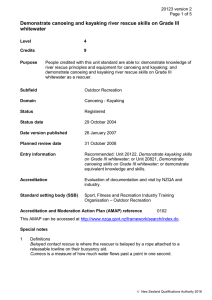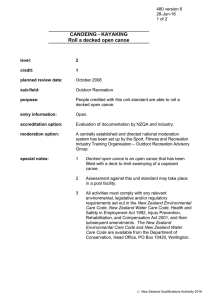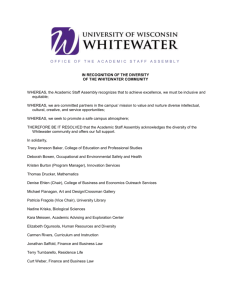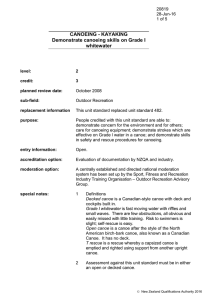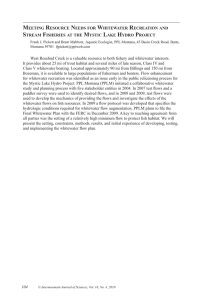Demonstrate canoeing skills on Grade III whitewater
advertisement
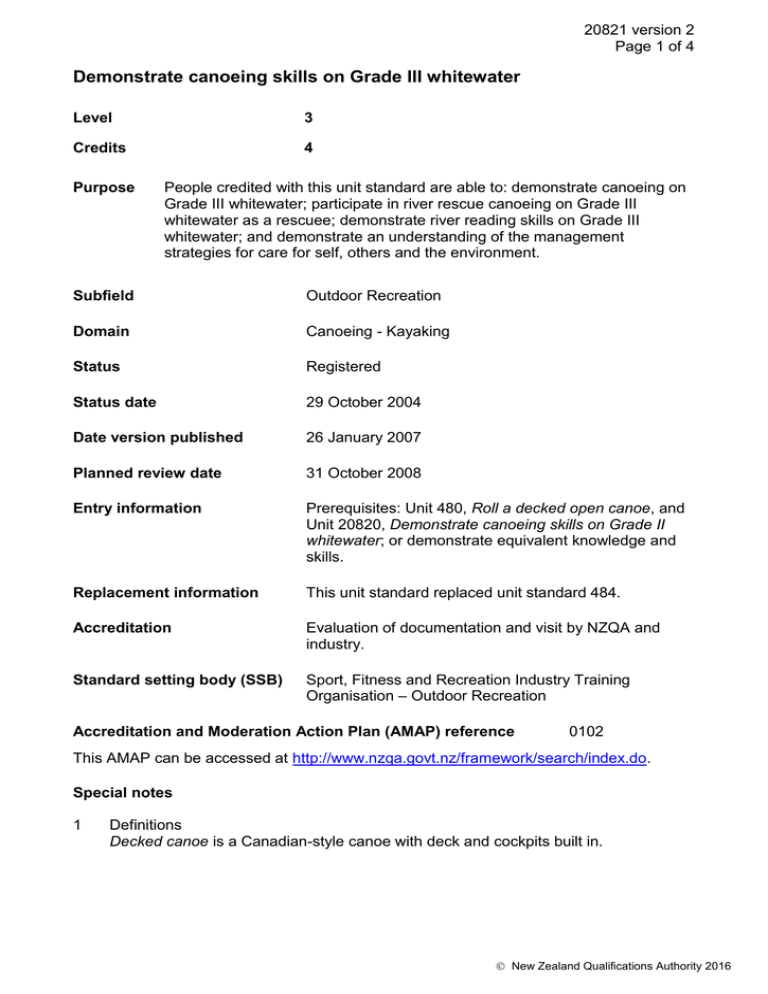
20821 version 2 Page 1 of 4 Demonstrate canoeing skills on Grade III whitewater Level 3 Credits 4 Purpose People credited with this unit standard are able to: demonstrate canoeing on Grade III whitewater; participate in river rescue canoeing on Grade III whitewater as a rescuee; demonstrate river reading skills on Grade III whitewater; and demonstrate an understanding of the management strategies for care for self, others and the environment. Subfield Outdoor Recreation Domain Canoeing - Kayaking Status Registered Status date 29 October 2004 Date version published 26 January 2007 Planned review date 31 October 2008 Entry information Prerequisites: Unit 480, Roll a decked open canoe, and Unit 20820, Demonstrate canoeing skills on Grade II whitewater; or demonstrate equivalent knowledge and skills. Replacement information This unit standard replaced unit standard 484. Accreditation Evaluation of documentation and visit by NZQA and industry. Standard setting body (SSB) Sport, Fitness and Recreation Industry Training Organisation – Outdoor Recreation Accreditation and Moderation Action Plan (AMAP) reference 0102 This AMAP can be accessed at http://www.nzqa.govt.nz/framework/search/index.do. Special notes 1 Definitions Decked canoe is a Canadian-style canoe with deck and cockpits built in. New Zealand Qualifications Authority 2016 20821 version 2 Page 2 of 4 Grade II whitewater contains straightforward rapids with wide, clear channels which are evident without scouting. Occasional manoeuvring may be required, but rocks and medium sized waves are easily missed by trained paddlers. Swimmers are seldom injured and group assistance, while helpful, is seldom needed. Grade III whitewater contains rapids with moderate, irregular waves which may be difficult to avoid. Complex manoeuvres in fast current and good control in tight passages or around ledges is often required; large waves or strainers may be present but are easily avoided. Strong eddies and powerful current effects can be found, particularly on large-volume rivers. Scouting is advisable for inexperienced parties. Injuries while swimming are rare; self-rescue is usually easy but group assistance may be required to avoid long swims. Open canoe is a canoe after the style of the North American birch-bark canoe, also known as a Canadian Canoe. It has no deck. T rescue is a rescue whereby a capsized canoe is emptied and righted using support from another upright canoe. 2 Assessment against this unit standard must be in either an open or decked canoe. 3 All activities must comply with any relevant environmental, legislative and/or regulatory requirements set out in the New Zealand Environmental Care Code, New Zealand Water Care Code, Health and Safety in Employment Act 1992, Injury Prevention, Rehabilitation, and Compensation Act 2001, and their subsequent amendments. The New Zealand Environmental Care Code and New Zealand Water Care Code are available from the Department of Conservation, Head Office, PO Box 10420, Wellington, http://www.doc.govt.nz/. 4 There are minimum assessor requirements for assessment against this unit standard. The details of these requirements are available on the Sfrito website http://www.sfrito.org.nz/. Elements and performance criteria Element 1 Demonstrate canoeing on Grade III whitewater. Performance criteria 1.1 Effective paddling strokes from both front and back positions are demonstrated. Range 1.2 forward, reverse draw (rudder), low brace, stern pry, bow draw, J stroke. Controlled turns are demonstrated. Range turn in main current, avoid obstacles. 1.3 Forward ferry and reverse gliding are demonstrated. 1.4 Breaking in to and out of eddies effectively is demonstrated. New Zealand Qualifications Authority 2016 20821 version 2 Page 3 of 4 1.5 Following lines down a Grade III whitewater rapid is demonstrated. 1.6 A roll in a canoe in Grade II whitewater is demonstrated. Element 2 Participate in canoeing river rescues on Grade III whitewater as a rescuee. Performance criteria 2.1 Rescue procedures as a rescuee are demonstrated. Range may include but is not limited to – T rescue, barrel roll. 2.2 Stern deck carry is demonstrated. 2.3 Throw bag rescue as a swimmer is demonstrated. 2.4 Swimming a Grade III whitewater rapid is demonstrated. Element 3 Demonstrate river reading skills on Grade III whitewater. Performance criteria 3.1 The dynamics of rivers are identified. Range 3.2 An awareness of river hazards, their effects on the canoe, and methods of avoiding them are demonstrated. Range 3.3 must include but not limited to – holes, eddies, waves, channels, bends. strainers, sieves, man-made objects, walls, undercuts, stoppers, weirs. Understanding of river dynamics of a Grade III rapid, including suggesting an appropriate line, is demonstrated. Element 4 Demonstrate an understanding of the management strategies for care for self, others, and environment. Performance criteria 4.1 Knowledge of management strategies for potential health problems associated with Grade III whitewater is demonstrated. Range hypothermia, cold water immersion, cramps, sunburn, blisters, dislocations, head injuries. New Zealand Qualifications Authority 2016 20821 version 2 Page 4 of 4 4.2 The New Zealand Environmental Care Code and New Zealand Water Care Code are applied. 4.3 Communications systems are identified and understood on and off the water. Range hand, paddle and whistle signals; voice. Please note Providers must be accredited by the Qualifications Authority, or an inter-institutional body with delegated authority for quality assurance, before they can report credits from assessment against unit standards or deliver courses of study leading to that assessment. Industry Training Organisations must be accredited by the Qualifications Authority before they can register credits from assessment against unit standards. Accredited providers and Industry Training Organisations assessing against unit standards must engage with the moderation system that applies to those standards. Accreditation requirements and an outline of the moderation system that applies to this standard are outlined in the Accreditation and Moderation Action Plan (AMAP). The AMAP also includes useful information about special requirements for organisations wishing to develop education and training programmes, such as minimum qualifications for tutors and assessors, and special resource requirements. Comments on this unit standard Please contact the Sport, Fitness and Recreation Industry Training Organisation info@sfrito.org.nz if you wish to suggest changes to the content of this unit standard. New Zealand Qualifications Authority 2016
